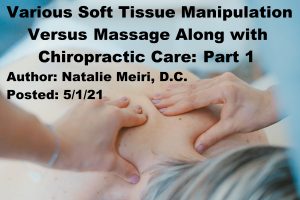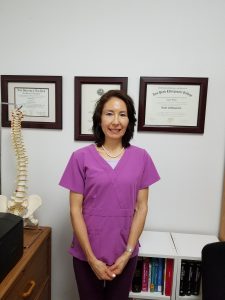
A common source of pain and disability is soft tissue injury with its resultant fibrosis and loss of elasticity and strength. Soft tissue injury and fibrosis may result from acute or repetitive trauma to muscular, tendinous, myofascial, or ligamentous tissue. Therefore, adjustments of the joint without attention to the supporting and controlling effects of the soft tissues (i.e. muscles, tendons, ligaments, fascia) will likely result in recurrence of joint dysfunction (misalignment of joint). The reason being, abnormal soft tissue patterns and presentations may persist after joint function has been restored. Accordingly, any soft tissue problems need to be treated along with the joint dysfunction.
Most chiropractic adjustive techniques (adjustments) impart a thrust to move a joint into proper alignment of the body to normalize function. In contrast, many manual therapy procedures (joint mobilization, traction, and soft tissue techniques) are designed to affect physiologic processes to normalize function without using a thrust. This post will focus on soft tissue manipulation (STM) techniques. STM techniques are defined as those physical methods applied to muscles, ligaments, tendons, fascia, and other connective tissues with the goal of therapeutically affecting the body.
Indeed, various and numerous forms of STM exist within the profession of chiropractic. Firstly, all STM techniques are not equivalent. Secondly, while all are often recommended for the relief of pain, all STM techniques are not interchangeable. Thirdly, although all STM techniques have some effect on the soft tissues, one may be more appropriate or effective for a particular condition.
Various Soft Tissue Manipulation Versus Massage Along With Chiropractic Care: the Restrictive Barrier Concept
Probably the most well known soft tissue technique is massage (methodical, friction and kneading of the body upon bare skin). Subsequently, some chiropractors do not use manual therapy (non thrust techniques) and refer their patients for massage (i.e. deep tissue) because of the exclusiveness of adjustments (thrust techniques). And in the chiropractic practice, one of the functions of massage is to relax your muscles. This prepares the irritated region for adjustments.
So massage is great for pain reduction, relaxation, improved circulation and even softens superficial fascia. However, massage is not soft tissue manipulation therapy which crosses the restrictive barrier. Many conditions require the restrictive barrier to be found and accurately engaged to provide functional improvement. The barrier concept provides an important distinction between massage procedures and other STM techniques.
You cannot get whichever therapy (massage) you prefer and expect the same outcome. Some soft tissue injuries/conditions may require a soft tissue manipulation technique beyond massage for restoration of full functional and/or structural improvement. Furthermore, when considering the use of treatment of certain soft tissue conditions a working knowledge of the fundamental principles behind them is necessary and helpful.

Education
Chiropractors have far more education than a massage therapist. A chiropractor has to complete a four-year undergraduate degree and then must finish a four-year doctorate of chiropractic program. All chiropractic programs teach a comprehensive program incorporating elements of basic science (e.g., physiology, anatomy, and biochemistry), clinical science (e.g., laboratory diagnosis, radiographic diagnosis, orthopedics, neurology, and nutrition), and clinical intern experience.
During their education, chiropractors also have to complete a residency program that includes hands-on training, pass several board exams, and pass certification tests. In conclusion, government inquiries and comparative evaluations have determined that the coursework and hours of instruction in the basic sciences are very similar between chiropractic and medical schools. Chiropractic students on average spend more hours in anatomy and physiology and fewer hours in public health. In the clinical arena chiropractic students have very limited training in pharmacology and critical care, but have significantly more training in clinical biomechanics, neuromusculoskeletal diagnosis, manual therapy, and exercise rehabilitation.
Part II of this post will discuss some various soft tissue manipulation techniques utilized at Meiri Chiropractic such as:
FUNCTIONAL TECHNIQUES
Strain-counterstrain
Positional release technique
MRT, Myofascial release technique
MANUAL RESISTANCE TECHNIQUES
MET, Muscle energy technique
PIR, post isometric relaxation
PNF, proprioceptive neuromusculoskeletal facilitation
Ischemic compression
Trigger point therapy
Receptor-tonus technique
BODY WALL REFLEX TECHNIQUES
Acupressure point stimulation
Chapman lymphatic reflexes
Bennett vascular reflexes
If you just need to relax and treat yourself, you should head to a massage therapist. However, if you have more serious complaints, such as back/neck pain, frequent headaches, TMJ pain or even arm and leg pain, you may get more benefits from chiropractic soft tissue manipulation techniques. Call Meiri Chiropractic today at 561-253-8984 to make an appointment or to learn more about various soft tissue manipulation versus massage along with chiropractic care: Part 1 in West Palm Beach.
References:
Bergman, Thomas. Peterson, Lawrence. Chiropractic Technique Principles and Procedures
2011. Third Edition
Hammer, Warren. Functional Soft Tissue Examination and Treatment by Manual Methods.
Third Edition
Video on same post
Meiri Chiropractic
561-253-8984